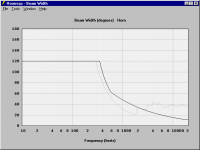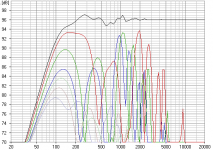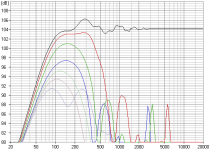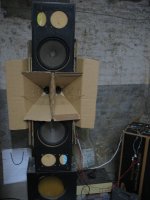Hello,
here is Natural, a design principle for a quite loud and beaming but neither too big nor too expensive (electric parts wise) active two-way loudspeaker with a phase turn of either 0 or Pi somewhere thru the lower half of audible frequency range. Natural is Synergy plus better horn plus finer woofer mesh minus sound compression minus DSP. It consists of
* a highpass made of a horn driven by one broad-range driver
* a lowpass consisting of four or eight direct-radiating woofers
* a line-level crossover
* a power amplifier for each pass.
Regarding the horn, as sound shall not become compressed, diaphragm size is given by, how much dispersion is needed at upper limit frequency. A rudimentary phase plug, for example a plaster egg in front of a 6 1/2 inch driver, raises output at his frequency. Contour and size of the horn determine beaming at lower frequencies. I suggest a contour of arithmetic mean of conical and exponential, balancing acoustic loading and flat beamwidth.
Driver needs to come with high treble efficiency, also look at electrical impedance. For thermal protection I use medium-fast-acting wire fuses, they are well suited and simple.
Woofers are sat at horn perimeter or some way into it but fully open, not behind a port. In order to be able to mount the woofers as close together as possible and to reduce distance between adjacent woofers, one uses many woofers.
I use a hipass of first and a lopass of second order. First order for good time response: With the run-time due to the horn, the sum shall have good pulse response. Second order for dampening of lobes: As the horn beams rather narrowly, woofers must not spoil that off-axis silence.
One may also use a cascade of allpasses for electrically adjusting sound travel time. Allpass of first order with operational amplifier:
SourceVoltage-2R-NegativeInput-2R-OutputVoltage
SourceVoltage-R-(PositiveInput|C)
This causes a frequency(phase turn of Pi/2) = 1/2PiRC and a time delay below that frequency of t(delay)=RC/Pi.
Uli
here is Natural, a design principle for a quite loud and beaming but neither too big nor too expensive (electric parts wise) active two-way loudspeaker with a phase turn of either 0 or Pi somewhere thru the lower half of audible frequency range. Natural is Synergy plus better horn plus finer woofer mesh minus sound compression minus DSP. It consists of
* a highpass made of a horn driven by one broad-range driver
* a lowpass consisting of four or eight direct-radiating woofers
* a line-level crossover
* a power amplifier for each pass.
Regarding the horn, as sound shall not become compressed, diaphragm size is given by, how much dispersion is needed at upper limit frequency. A rudimentary phase plug, for example a plaster egg in front of a 6 1/2 inch driver, raises output at his frequency. Contour and size of the horn determine beaming at lower frequencies. I suggest a contour of arithmetic mean of conical and exponential, balancing acoustic loading and flat beamwidth.
Driver needs to come with high treble efficiency, also look at electrical impedance. For thermal protection I use medium-fast-acting wire fuses, they are well suited and simple.
Woofers are sat at horn perimeter or some way into it but fully open, not behind a port. In order to be able to mount the woofers as close together as possible and to reduce distance between adjacent woofers, one uses many woofers.
I use a hipass of first and a lopass of second order. First order for good time response: With the run-time due to the horn, the sum shall have good pulse response. Second order for dampening of lobes: As the horn beams rather narrowly, woofers must not spoil that off-axis silence.
One may also use a cascade of allpasses for electrically adjusting sound travel time. Allpass of first order with operational amplifier:
SourceVoltage-2R-NegativeInput-2R-OutputVoltage
SourceVoltage-R-(PositiveInput|C)
This causes a frequency(phase turn of Pi/2) = 1/2PiRC and a time delay below that frequency of t(delay)=RC/Pi.
Uli
Last edited:
Thanks, Billy!
What i have built yet, is a light-weight front-loaded horn originally meant as fullrange, containing a 6 1/2 inch Visaton BG17 with a plaster egg in front, 1 m long with a 70x70cm big mouth. From mostly cardboard, some MDF and wood, artificial resin and starch glue. This horn reaches bass if sat in a corner and plays trebles well. But it beams strongly, having a beamwidth of only one hour (Pi/6):
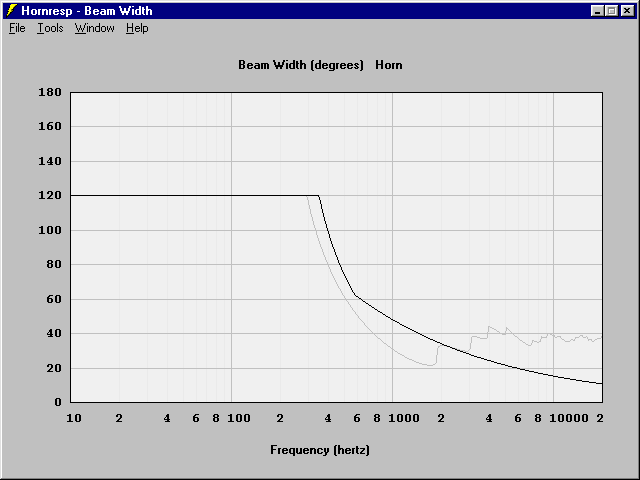 Black is exponential, grey conical.
Black is exponential, grey conical.
An advantage is, that it fits thru most doors and in most car backs. I could build another one and snug it against the first one, making a sectoral horn, so beamwidth is doubled in one dimension. I designed it with this possibility in the back of my mind, no obstructing parts. Or even build another two and double beamwidth in both dimensions. Quite an effort, tho. I could also buy woofers and pimp bass and strength. For i am not comfortable with adding on something out of phase, i would need a crossover of first order.
If i use eight 6 1/2 inch woofers in such a way, that distances between neighbouring drivers equal, the pattern is the same horizontally, vertically and diagonally. With a crossover of just first order, lobes dominate off the narrow horn beam:
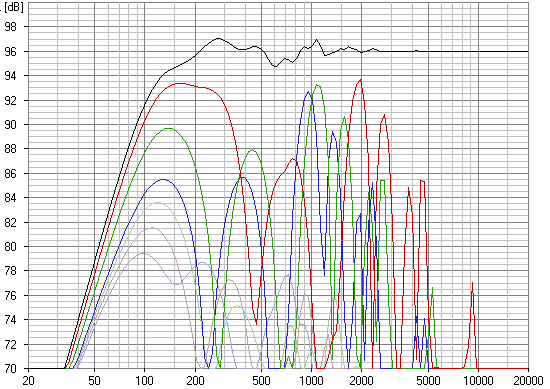
This is woofer array response without X-over at red +-1h, green +-2h and blue +-3h. For i plan to use the loudspeaker in a reflective environment with people standing in and sitting off the horn beam, this is not good.
Using twenty such woofers in a square pattern, spatial aliasing is reduced horizontally and vertically:
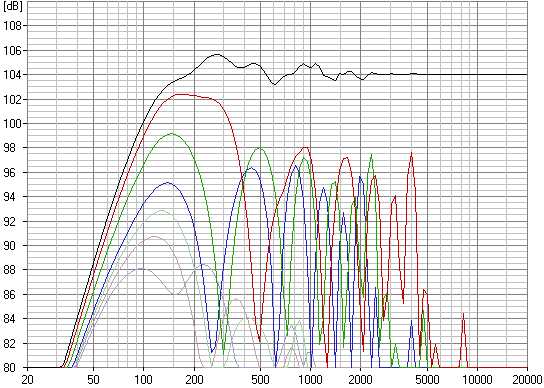
and nearly removed diagonally:
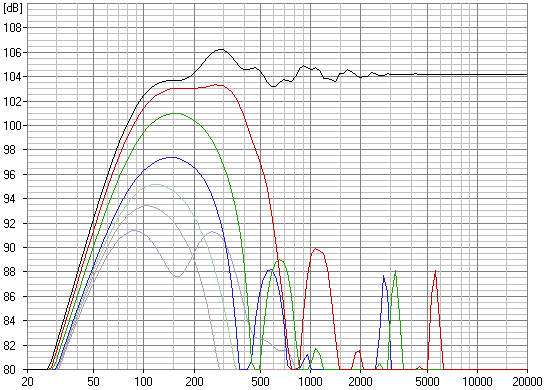 The array with twenty drivers would work sonically but loose the light-weightedness of my earlier work, unless i take drivers with tiny voice coil and magnet, very soft suspension and plastic basket.
The array with twenty drivers would work sonically but loose the light-weightedness of my earlier work, unless i take drivers with tiny voice coil and magnet, very soft suspension and plastic basket.
Yours, Uli
What i have built yet, is a light-weight front-loaded horn originally meant as fullrange, containing a 6 1/2 inch Visaton BG17 with a plaster egg in front, 1 m long with a 70x70cm big mouth. From mostly cardboard, some MDF and wood, artificial resin and starch glue. This horn reaches bass if sat in a corner and plays trebles well. But it beams strongly, having a beamwidth of only one hour (Pi/6):
An advantage is, that it fits thru most doors and in most car backs. I could build another one and snug it against the first one, making a sectoral horn, so beamwidth is doubled in one dimension. I designed it with this possibility in the back of my mind, no obstructing parts. Or even build another two and double beamwidth in both dimensions. Quite an effort, tho. I could also buy woofers and pimp bass and strength. For i am not comfortable with adding on something out of phase, i would need a crossover of first order.
If i use eight 6 1/2 inch woofers in such a way, that distances between neighbouring drivers equal, the pattern is the same horizontally, vertically and diagonally. With a crossover of just first order, lobes dominate off the narrow horn beam:
This is woofer array response without X-over at red +-1h, green +-2h and blue +-3h. For i plan to use the loudspeaker in a reflective environment with people standing in and sitting off the horn beam, this is not good.
Using twenty such woofers in a square pattern, spatial aliasing is reduced horizontally and vertically:
and nearly removed diagonally:
Yours, Uli
Attachments
Last edited:
I have settled on a balance: I am gonna turn the highpass into a resonance-free Linkwitz-Riley one by notching 100 Hz horn resonance. Eight woofers with a complementary Linkwitz-Riley lowpass. This way, i have fortunately extended amplitude response and infortunately introduced a phase switch around 100 Hz.
Last edited:
Hi, thrown over that balance, for you pointed me towards Harsch X-overs enabling good pulse response without the need for a first-order crossover. H uses a fourth-order Butterworth filter, which I do not like for its ringing, rather a hybrid of HX and first order, as already edited into the headpost and shown at the end of this post. The horn designed with David's Hornresp:

Sat on the floor reaching 100Hz, mainly consisting of up to three layers of three-layered corrugated cardboard.
Those woofers, whose TSP are published there (the second set). Foam surrounds have rotten in storage, so some waggoning damage occured, fixed with diluted silicone glue and toilet paper. Four above and four belo the horn, finally build a second horn and snug it against the first. X point 250Hz. (Woofers are usable up to at least 1 KHz.)
For warm-up I built a smaller loudspeaker with two modified Monarch SP-626/8 tweeters (they clang above 1KHz, where one hears it the best, so I treated paper surrounds with silicone, now they notch 2KHz) in a duo-sectoral horn, two modified Heco Soundmaster 35 loudspeakers and a passive X-over:
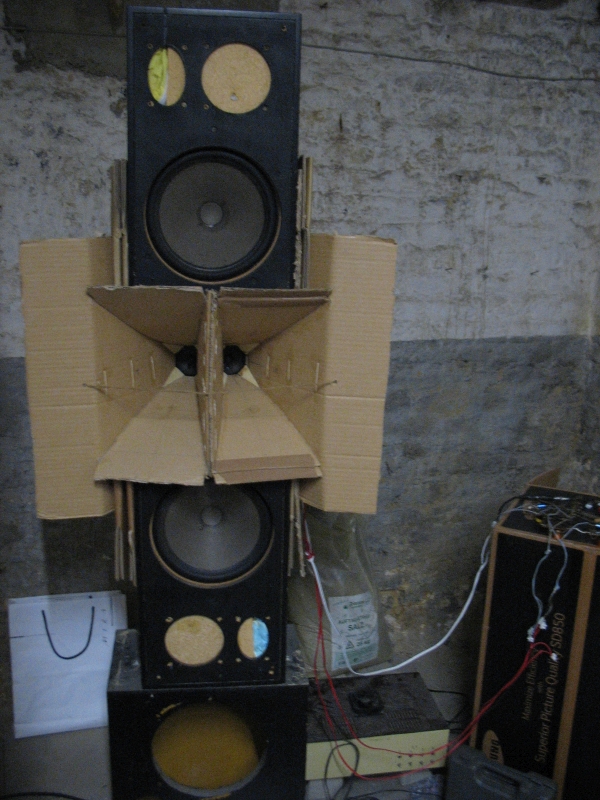
X-over designed for 1KHz:

Relative SPLs do fit approximately, does not sound too bad, altho distance between woofers is too great for 1KHz XO, and there is cancellation around 450Hz, when the horn ceases to work and turns phase( may notch this frequency within the hi-pass). Feels good to hear a bigger loudspeaker of one's own built playing one's own musak in one's parents' cellar.
Sat on the floor reaching 100Hz, mainly consisting of up to three layers of three-layered corrugated cardboard.
Those woofers, whose TSP are published there (the second set). Foam surrounds have rotten in storage, so some waggoning damage occured, fixed with diluted silicone glue and toilet paper. Four above and four belo the horn, finally build a second horn and snug it against the first. X point 250Hz. (Woofers are usable up to at least 1 KHz.)
For warm-up I built a smaller loudspeaker with two modified Monarch SP-626/8 tweeters (they clang above 1KHz, where one hears it the best, so I treated paper surrounds with silicone, now they notch 2KHz) in a duo-sectoral horn, two modified Heco Soundmaster 35 loudspeakers and a passive X-over:
X-over designed for 1KHz:
Relative SPLs do fit approximately, does not sound too bad, altho distance between woofers is too great for 1KHz XO, and there is cancellation around 450Hz, when the horn ceases to work and turns phase( may notch this frequency within the hi-pass). Feels good to hear a bigger loudspeaker of one's own built playing one's own musak in one's parents' cellar.
Attachments
- Status
- Not open for further replies.
